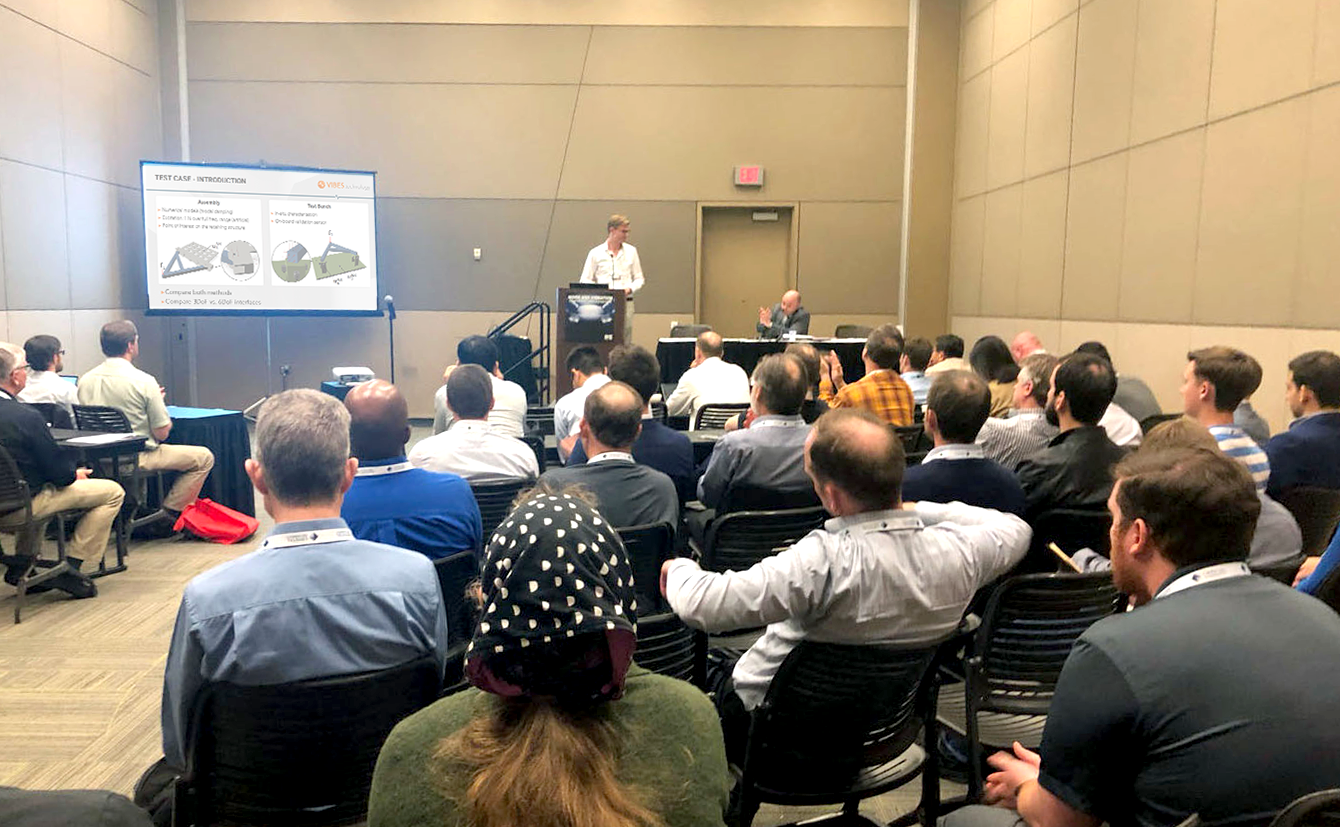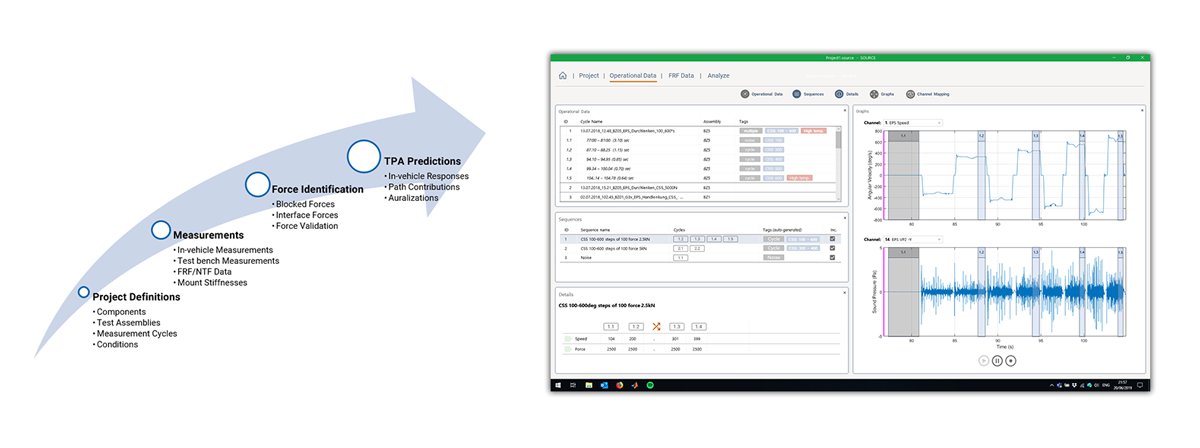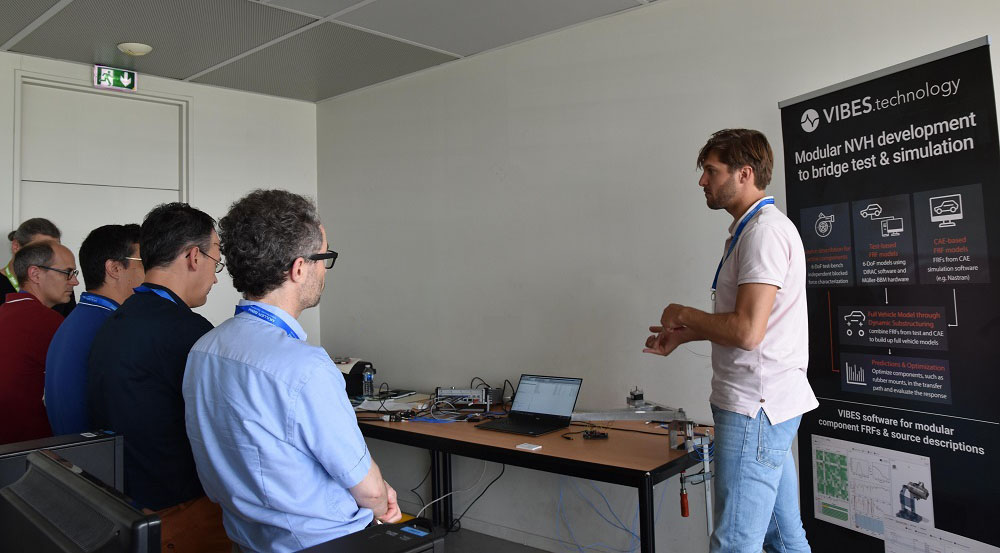New technology and software for blocked forces
17 July 2019
VIBES.technology is actively informing the NVH world, at various renowned conferences, on source characterization, TPA and applications to measure blocked forces and FRFs. This article gives an insight in the latest presentations and papers and gives a sneak-preview of our newest software application: SOURCE.
Blocked Forces and source characterization are trending topics in NVH engineering. Recently held SAE Noise & Vibration Conference showed once more the integral focus on source characterization of active components and the need for new, reliable and standardized methods.s.
Our presentation at the SAE NVH conference on two source characterization ISO standards was very well received. Maarten van der Kooij discussed the two standards from both a theoretical (TPA Framework) and practical (implementation) point of view. Overall, there was great interest in the session on “System NVH Approach – Influence of Coupled Parts”, organised by Thierry Bourdon (Continental Automotive France SAS) with contributions from other players such as University of Salford, Siemens and Bosch.
TPA framework and ISO standards
As part of the SAE NVH conference, VIBES published a paper addressing two important ISO standards in source characterization. Our efforts to explain this from a general TPA framework and compare the specifics of the two methods have been well appreciated by the community, proven by the great interests in and the large audiences attending our presentation at SAE NVH Conference and earlier this year at the IMAC conference and the SIA-CTTM Automotive NVH Comfort Conference.
As explained in the paper, a unique addition of VIBES is the use of Virtual Points in any force description in order to obtain moments. This increases the robustness of the method, the bandwidth of validity and avoids many problems when transferring force descriptions from the test bench situation (at the supplier) to the vehicle assembly (OEM). Furthermore, we are proud to say this paper (A Comparison of Two Source Characterization Techniques Proposed for Standardization) was chosen as one of the best submissions and will be re-published in the SAE International Journal of Advances and Current Practices in Mobility later this year.
VIBES has always played a pioneering role in the field of blocked force source characterization, both in method development and in bringing technology to the market with our software solutions. Currently we are helping major players in the (automotive) industry to successfully implement blocked forces in their existing NVH processes.
New software for independent source characterization
When it comes to software, VIBES keeps developing innovative applications that address the market’s needs. The latest software from the VIBES team provides solutions for independent source characterization and response prediction. SOURCE is the result of years of method and software development in the field of TPA, blocked forces and substructuring. As it operates natively with ATFX data, it can be used in virtually any engineering environment alongside the standard data acquisition systems and software solutions in the NVH industry.
Typical cases to use SOURCE:
- Blocked force characterization of vehicle mechatronic systems (e.g. EPS, e-compressor), measured at a component test bench, with forces and moments at 3kHz enabled by VP FRFs
- Combined classical and component TPA with both interface and blocked force source description, auralized into multiple virtual vehicles.
Results and insights generated by SOURCE fit perfectly in current CAE simulations, allowing to solve critical NVH aspects in an early phase of product development.
Generate high-quality and traceable blocked force and TPA calculations with SOURCE
Combining SOURCE with DIRAC
DIRAC in combination with SOURCE is the most effective solution for blocked force calculation. It ensures transferability of blocked forces between test bench and vehicle, as the virtual points guarantee true compatibility at the connecting points. The combination provides guidelines and multiple means of evaluating the quality of individual steps throughout the calculation process. Consequently, the overall quality of the analysis increases significantly.
Live demo: blocked forces in under 30 minutes
It is no longer just theoretical; we are now applying our methods and software applications to the industry. At the 2019 edition of JISFA, Le Mans this June, we demonstrated the exceptional combination of DIRAC and SOURCE. When combining these applications the measuring process becomes more efficient. Less steps are needed to run a full analysis, as no time (and quality!) is lost on data import and export. DIRAC and SOURCE are comprehensive applications, therefore increasing efficiency and clarity and reducing the time spent on NVH engineering by factor four! The live demonstration at the JISFA showcased this combination and demonstrated you can perform a complete virtual point blocked force analysis within 30 minutes.
What’s next?
VIBES uses SOURCE and DIRAC in customer projects and it has amazed both the customers and ourselves how quickly one gets an insights in critical NVH problems. We are excited to show you what this can do for your NVH engineering.
In the coming weeks, you will hear more about SOURCE, so stay tuned! In the meantime, if you want more info on blocked forces or our DIRAC software, please contact us at info@vibestechnology.com, call us at +31 85 744 0970 or use the contact form on our website.



